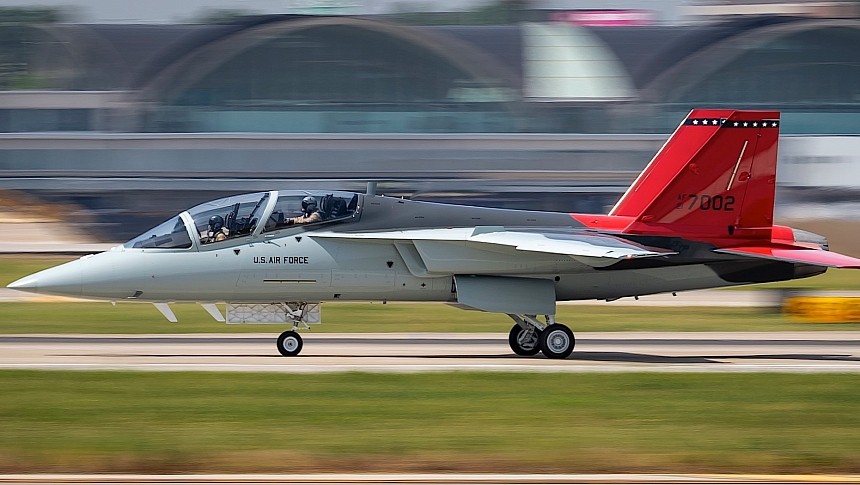The American military is in the middle of an extensive modernization program, with the Air Force (USAF) taking center stage. The branch is not only looking to modernize and streamline its fleet of fighting machines, but it also eyes upgrading to new planes when it comes to the training of pilots.
At the moment, most of America's flying aces learn the tricks of the trade using T-38 Talons. It's a machine that was born in the 1950s over at Northrop, and has been used extensively ever since by the Air Education and Training Command, Air Combat Command, Air Force Materiel Command, and even NASA.
But a 70-year-old airplane teaching pilots tricks in our day and age is a bit strange, so the USAF is planning to replace the Talon. The aircraft chosen for the task is called T-7A Red Hawk, and it's being put together by Boeing.
The plane flies thanks to a General Electric turbofan engine rated at 17,000 lbf of thrust (when using the afterburner). Its data sheet shows it will be capable of reaching a top speed of over 800 mph (1,300 kph) and a top altitude of 50,000 feet (15,000 meters).
The plane was named Red Hawk in honor of the Curtiss P-40 Warhawks of the Second World War, skillfully flown into combat by the almost all-African American group of pilots called the Tuskegee Airmen.
It is not expected to begin serving the needs of student pilots until sometime around 2027, but Boeing is hard at work testing various components of the aircraft. At the end of May, for instance, we learned of the plane's ejection seat system being put through its paces. Now, we get word of it having completed taxi tests, because a jet's ability to move on the ground is just as important as its ability to fly.
According to the test pilot who took the Red Hawk out for a joy ride on the runway, Steve Schmidt, the "flight controls and commands to the fly-by-wire system were crisp and the aircraft maneuvered exceptionally well."
Boeing calls the completion of the test "a critical step in verifying the ground-handling capabilities and systems," one which opens the doors to actual flight testing, on a larger scale, later this year.
Since it received the award for the plane in 2018, the aerospace company has built five development aircraft. Two of them have already been flown during six sorties, allowing the company to gather 7,000 data and test points. The true flight tests coming this fall will take place at the Edwards Air Force Base in California.
Eventually, Boeing will have to deliver 350 Red Hawk trainer airplanes to the USAF. For them, the company will receive a total of $9.2 billion.
But a 70-year-old airplane teaching pilots tricks in our day and age is a bit strange, so the USAF is planning to replace the Talon. The aircraft chosen for the task is called T-7A Red Hawk, and it's being put together by Boeing.
The plane flies thanks to a General Electric turbofan engine rated at 17,000 lbf of thrust (when using the afterburner). Its data sheet shows it will be capable of reaching a top speed of over 800 mph (1,300 kph) and a top altitude of 50,000 feet (15,000 meters).
The plane was named Red Hawk in honor of the Curtiss P-40 Warhawks of the Second World War, skillfully flown into combat by the almost all-African American group of pilots called the Tuskegee Airmen.
It is not expected to begin serving the needs of student pilots until sometime around 2027, but Boeing is hard at work testing various components of the aircraft. At the end of May, for instance, we learned of the plane's ejection seat system being put through its paces. Now, we get word of it having completed taxi tests, because a jet's ability to move on the ground is just as important as its ability to fly.
According to the test pilot who took the Red Hawk out for a joy ride on the runway, Steve Schmidt, the "flight controls and commands to the fly-by-wire system were crisp and the aircraft maneuvered exceptionally well."
Boeing calls the completion of the test "a critical step in verifying the ground-handling capabilities and systems," one which opens the doors to actual flight testing, on a larger scale, later this year.
Since it received the award for the plane in 2018, the aerospace company has built five development aircraft. Two of them have already been flown during six sorties, allowing the company to gather 7,000 data and test points. The true flight tests coming this fall will take place at the Edwards Air Force Base in California.
Eventually, Boeing will have to deliver 350 Red Hawk trainer airplanes to the USAF. For them, the company will receive a total of $9.2 billion.











